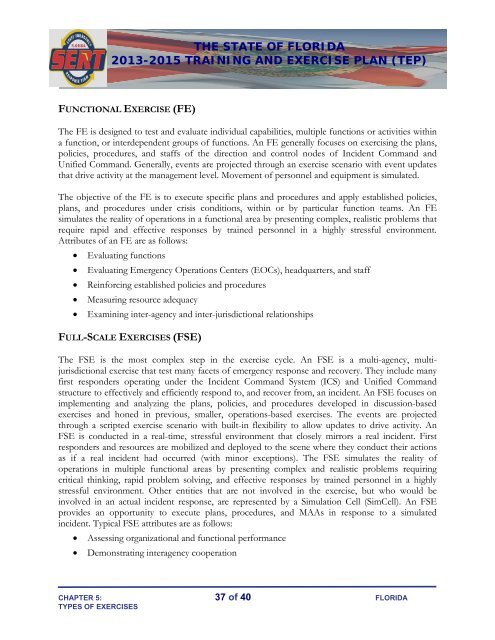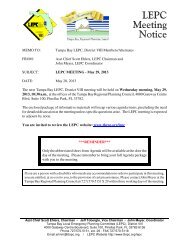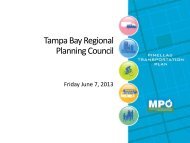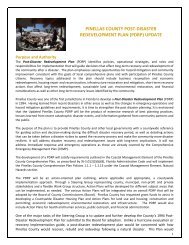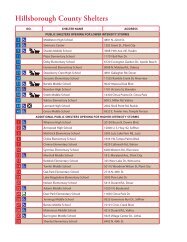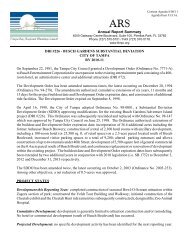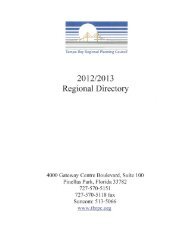State of Florida - Tampa Bay Regional Planning Council
State of Florida - Tampa Bay Regional Planning Council
State of Florida - Tampa Bay Regional Planning Council
You also want an ePaper? Increase the reach of your titles
YUMPU automatically turns print PDFs into web optimized ePapers that Google loves.
THE STATE OF FLORIDA<br />
2013-2015 TRAINING AND EXERCISE PLAN (TEP)<br />
FUNCTIONAL EXERCISE (FE)<br />
The FE is designed to test and evaluate individual capabilities, multiple functions or activities within<br />
a function, or interdependent groups <strong>of</strong> functions. An FE generally focuses on exercising the plans,<br />
policies, procedures, and staffs <strong>of</strong> the direction and control nodes <strong>of</strong> Incident Command and<br />
Unified Command. Generally, events are projected through an exercise scenario with event updates<br />
that drive activity at the management level. Movement <strong>of</strong> personnel and equipment is simulated.<br />
The objective <strong>of</strong> the FE is to execute specific plans and procedures and apply established policies,<br />
plans, and procedures under crisis conditions, within or by particular function teams. An FE<br />
simulates the reality <strong>of</strong> operations in a functional area by presenting complex, realistic problems that<br />
require rapid and effective responses by trained personnel in a highly stressful environment.<br />
Attributes <strong>of</strong> an FE are as follows:<br />
• Evaluating functions<br />
• Evaluating Emergency Operations Centers (EOCs), headquarters, and staff<br />
• Reinforcing established policies and procedures<br />
• Measuring resource adequacy<br />
• Examining inter-agency and inter-jurisdictional relationships<br />
FULL-SCALE EXERCISES (FSE)<br />
The FSE is the most complex step in the exercise cycle. An FSE is a multi-agency, multijurisdictional<br />
exercise that test many facets <strong>of</strong> emergency response and recovery. They include many<br />
first responders operating under the Incident Command System (ICS) and Unified Command<br />
structure to effectively and efficiently respond to, and recover from, an incident. An FSE focuses on<br />
implementing and analyzing the plans, policies, and procedures developed in discussion-based<br />
exercises and honed in previous, smaller, operations-based exercises. The events are projected<br />
through a scripted exercise scenario with built-in flexibility to allow updates to drive activity. An<br />
FSE is conducted in a real-time, stressful environment that closely mirrors a real incident. First<br />
responders and resources are mobilized and deployed to the scene where they conduct their actions<br />
as if a real incident had occurred (with minor exceptions). The FSE simulates the reality <strong>of</strong><br />
operations in multiple functional areas by presenting complex and realistic problems requiring<br />
critical thinking, rapid problem solving, and effective responses by trained personnel in a highly<br />
stressful environment. Other entities that are not involved in the exercise, but who would be<br />
involved in an actual incident response, are represented by a Simulation Cell (SimCell). An FSE<br />
provides an opportunity to execute plans, procedures, and MAAs in response to a simulated<br />
incident. Typical FSE attributes are as follows:<br />
• Assessing organizational and functional performance<br />
• Demonstrating interagency cooperation<br />
CHAPTER 5: 37 <strong>of</strong> 40 FLORIDA<br />
TYPES OF EXERCISES


